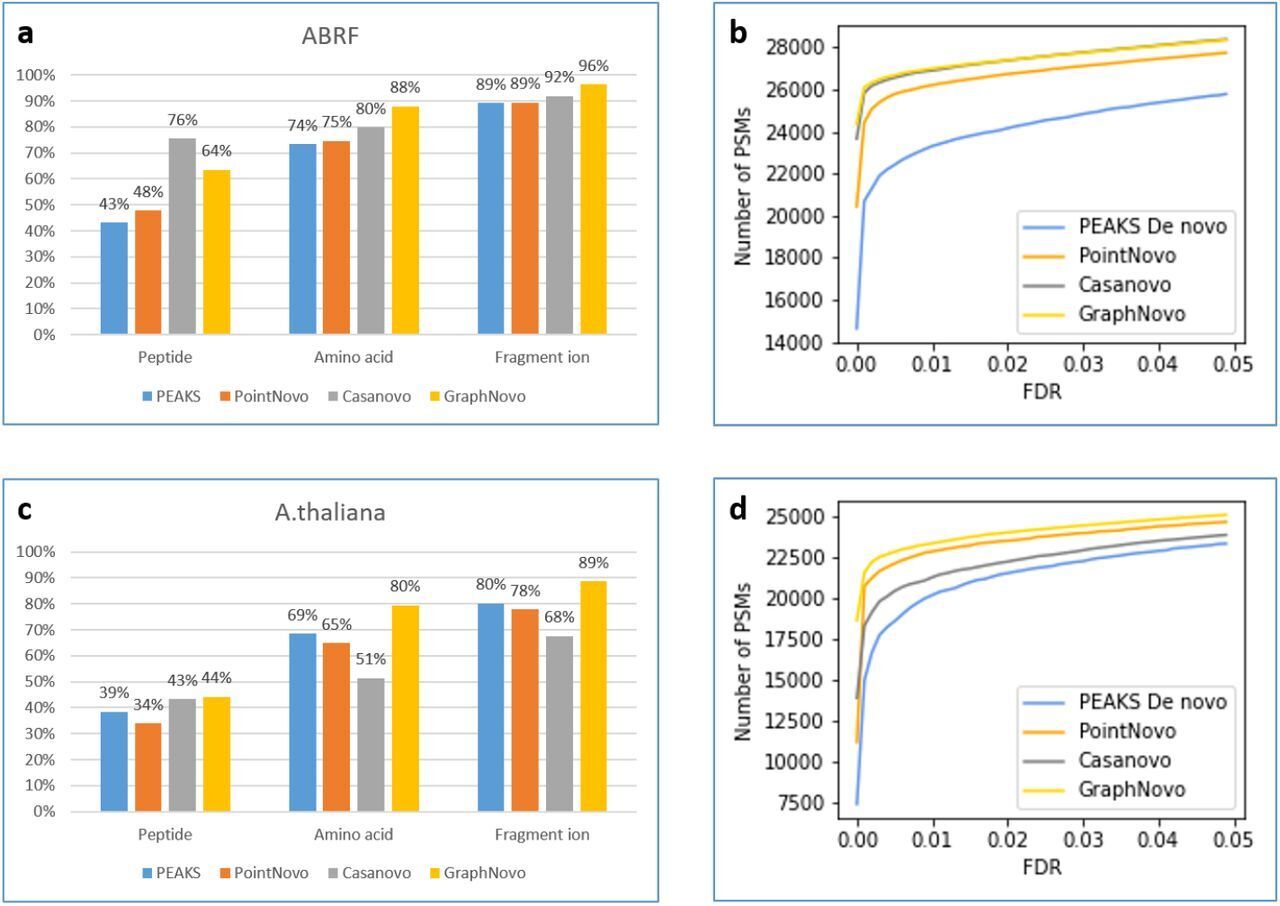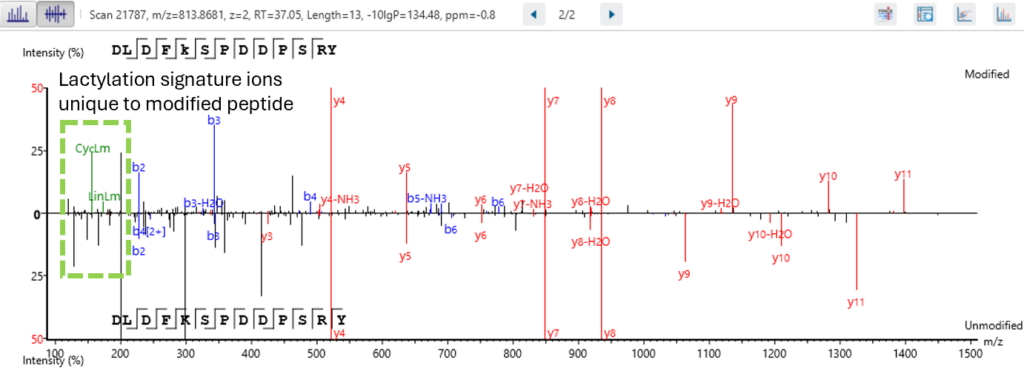

PEAKS Studio 12.5 introduces improved processing times for both CPU and GPU utilisations, support for the new ZT Scan DIA technology, improved DIA Data and Result View, and updated Hybrid-PRM/DIA workflow.
New Features
PEAKS DIA
- Faster Processing times for both CPU and GPU run analyses.
- ZT Scan DIA Support with Q1 dimension for improved sensitivity and accuracy.
- Improved LC/MS data view for DIA data – now the user can manually validate both precursors and fragments.
Hybrid-PRM/DIA
- Updated Hybrid-PRM/DIA workflow for enhanced user experience of this new methodology combining the power of DIA and sensitivity of PRM.
DeepNovo Peptidome Workflow
- Adding to PEAKS unique peptidome solution, now On-the-fly Personalised allele-specific Training is available to boost confidence for patient specific samples.
PEAKS 12.5 features are enhancing those added in PEAKS 12 earlier in the year…
PEAKS DIA Workflows
- Up to 20% increase in peptide/protein identification and quantification
- Hybrid-DIA for targeted and discovery-driven clinical proteomics
DeepNovo Peptidome workflow
- Gene table to bridge the gap between proteomics and genomics
- Support for non-canonical reference sequences
- Label-free quantification and automated QC tool
- DeepNovo-DIA peptidome workflow
DeepNovo Workflow
- Upgraded DeepNovo function with GraphNovo algorithms [1]
- New FDR Estimation for de novo sequencing
PRM Workflow
- New PRM Targeted Quantification
- Transition list export: from DIA LFQ results, users can export PRM and MRM transition lists
Label-free quantification
- Feature Based LFQ: LFQ result with feature vectors with and without identification.
- Label-free Quantification Principal Component Analysis (PCA) plot added to all LFQ results
Post-translational modification (PTM) and Mutations analysis
- Next level confidence: confident PTM/mutation sites identification based on amino acid level evidence
User experience, automation, and more
- Batch submission option
- Database validation
- Data Refine feature filter
- Automatic export option
- Image export in SVG format
- PSM ion export
PEAKS®: Advanced Proteomics Solution
PEAKS® is a specialised tool that offers unrivalled peptide identification rates driven by deep learning technology integrated with library search, direct database search and de novo sequencing. PEAKS® 12 supports data-dependent and data-independent acquisition analyses (DDA and DIA respectively) and ion mobility mass spectrometry (IMS-MS) with the IMS add-on module. As a vendor-neutral computing platform, PEAKS® is capable of directly loading raw mass spectrometry data and standard data formats. Deploy the PEAKS® workflows to identify the presence of peptides and proteins in your project for 1) DDA data analysis including de novo sequencing, PEAKS DB (database search) identification, PEAKS PTM (post translational modification) analysis, SPIDER homology search and PEAKS DeepNovo Peptidome (specialised workflow for peptidomics data) and 2) DIA data analysis including PEAKS DIA Workflow (spectral library search, direct database searching and de novo sequencing),and DeepNovo-DIA Peptidome.
Quantification analysis by labelling and label-free quantification (LFQ) can also be performed using the PEAKS Q add-on module. Intuitive result visualisation tools are provided at every stage of analysis and results can be exported. Targeted data analysis includes PEAKS PRM Quantification and Hybrid-PRM/DIA.
Faster Processing Times for DIA with or without a GPU.
PEAKS 12.5 processes DIA data ~ 20% faster than PEAKS 12, when the GPU is used. In addition, the algorithm has been optimised to better take advantage of CPU resource and thus achieve increased analysis speeds.

New and Improved DIA Refined Data and Peptide Result View

PEAKS Data Refine LCMS view now provides more options for visualising precursors, MS/MS windows, identifications, and de novo tags. It is now easy to distinguish between identifications with and without a precursor. Identifications with a precursor are coloured in blue and identifications without a precursor are coloured in red.
Seamlessly move between the Peptides tab and LCMS map for a given peptide. Visualise overlapping precursors on the LCMS map with associated identifications. Click on an identification in the LCMS map to show each fragment ion as a function of retention time. PEAKS can distinguish overlapping precursors from modified (e.g. Deamidation) and unmodified peptides as well as isobaric peptides with varying modifications positioning

PEAKS Support for the ZT Scan DIA technology
PEAKS 12.5 introduces the support for the latest ZT Scan DIA technology from SCIEX. PEAKS algorithm integrates the Q1 dimension information from ZT Scan DIA into its scoring function for improved identification sensitivity, reproducibility, and quantitative precision.

PEAKS Solution for Hybrid-PRM/DIA
The Hybrid-DIA technology by Thermo, available exclusively in PEAKS Studio, combines targeted and discovery-driven approaches, making it ideal for clinical proteomics applications.
Hybrid-PRM/DIA is a new intuitive data acquisition strategy that enables enhanced sensitivity for a specific set of analyses by the intelligent triggering of multiplexed parallel reaction monitoring (PRM) in combination with the discovery driven digitisation of the clinical biospecimen using DIA. Heavy labelled reference peptides are utilised as triggers for PRM and monitoring of endogenous peptides.

Expansive DIA solution with hyper accurate PEAKS DIA Workflow and NEW Hybrid-DIA
PEAKS® DIA workflows provide a comprehensive solution for peptide and protein identification and quantification, achieving up to 20% increase in identification rates.

Additionally, the Reporter Ion Quantification (RIQ) Boxplot feature offers robust visualisation of quantification data. Furthermore, the platform allows for spectral library export of peptides with confident post-translational modifications (PTMs) and mutations identified in PEAKS PTM and SPIDER DDA workflows. This integration of advanced features ensures that PEAKS® DIA workflows deliver high accuracy and depth in proteomics research.
Enhanced DeepNovo Peptidome with LFQ for DDA and DIA analysis
The DeepNovo Peptidome workflow is designed to bridge the gap between proteomics and genomics through the integration of a comprehensive gene table.
This feature facilitates a seamless connection between peptide identification and corresponding genomic data. The workflow supports non-canonical reference sequences, allowing for the identification of variant and modified sequences that are often missed by standard canonical reference databases.

For quantitative analysis, the workflow includes robust label-free quantification capabilities, complemented by an automated QC tool to ensure data quality and reliability.
Additionally, the DeepNovo-DIA peptidome workflow extends these capabilities to data-independent acquisition (DIA) data, providing a powerful solution for detailed peptidome profiling and ensuring high accuracy in peptide and protein identification.
The NEW upgraded DeepNovo analysis is the fastest and most accurate PEAKS peptide de novo sequencing
The DeepNovo workflow has been significantly upgraded with the incorporation of GraphNovo algorithms, enhancing the accuracy and efficiency of de novo peptide sequencing. [1]


With GPU’s this upgrade leverages advanced graph-based methods to improve peptide identification, especially in complex samples. Additionally, as a GPU-enabled analysis the processing speed is dramatically increased and allows for faster data analysis


A new False Discovery Rate (FDR) estimation method has been implemented, providing more reliable and accurate control of false positives in de novo sequencing. These enhancements make the DeepNovo workflow a powerful tool for cutting-edge proteomics research, offering unprecedented speed and precision in peptide and protein identification.


PEAKS PRM is the first targeted quantification workflow integrated into PEAKS
PEAKS 12 features a new PRM Targeted Quantification workflow that is precise and reliable for quantifying specific peptides in complex biological samples.
This targeted approach allows researchers to focus on predefined peptides of interest, ensuring accurate and reproducible quantification even in the presence of interfering substances. The new PRM Targeted Quantification capability significantly improves the workflow’s sensitivity and specificity, making it an indispensable tool for detailed proteomic studies and biomarker validation. By integrating this advanced feature, the PRM Workflow offers a robust solution for high-confidence absolute quantification in targeted proteomics.
Next level confidence: confident PTM/mutation sites identification based on amino acid level evidence
The Post-Translational Modification (PTM) and Mutations Analysis workflow offers next-level confidence by enabling the identification of PTM and mutation sites with high precision, grounded on amino acid level evidence.

This advanced capability allows researchers to pinpoint specific modifications and mutations within proteins, providing a detailed and accurate understanding of protein function and regulation. By leveraging robust algorithms and comprehensive data analysis, this workflow ensures that PTM and mutation sites are identified with exceptional confidence, facilitating deeper insights into protein dynamics and disease mechanisms. This enhanced analytical power is crucial for advancing our understanding of biological processes and developing targeted therapeutic strategies.

References & Resources
References
- Mao, Z., Zhang, R., Xin, L. et al. Mitigating the missing-fragmentation problem in de novo peptide sequencing with a two-stage graph-based deep learning model. Nat Mach Intell 5, 1250–1260 (2023). doi:10.1038/s42256-023-00738-x


